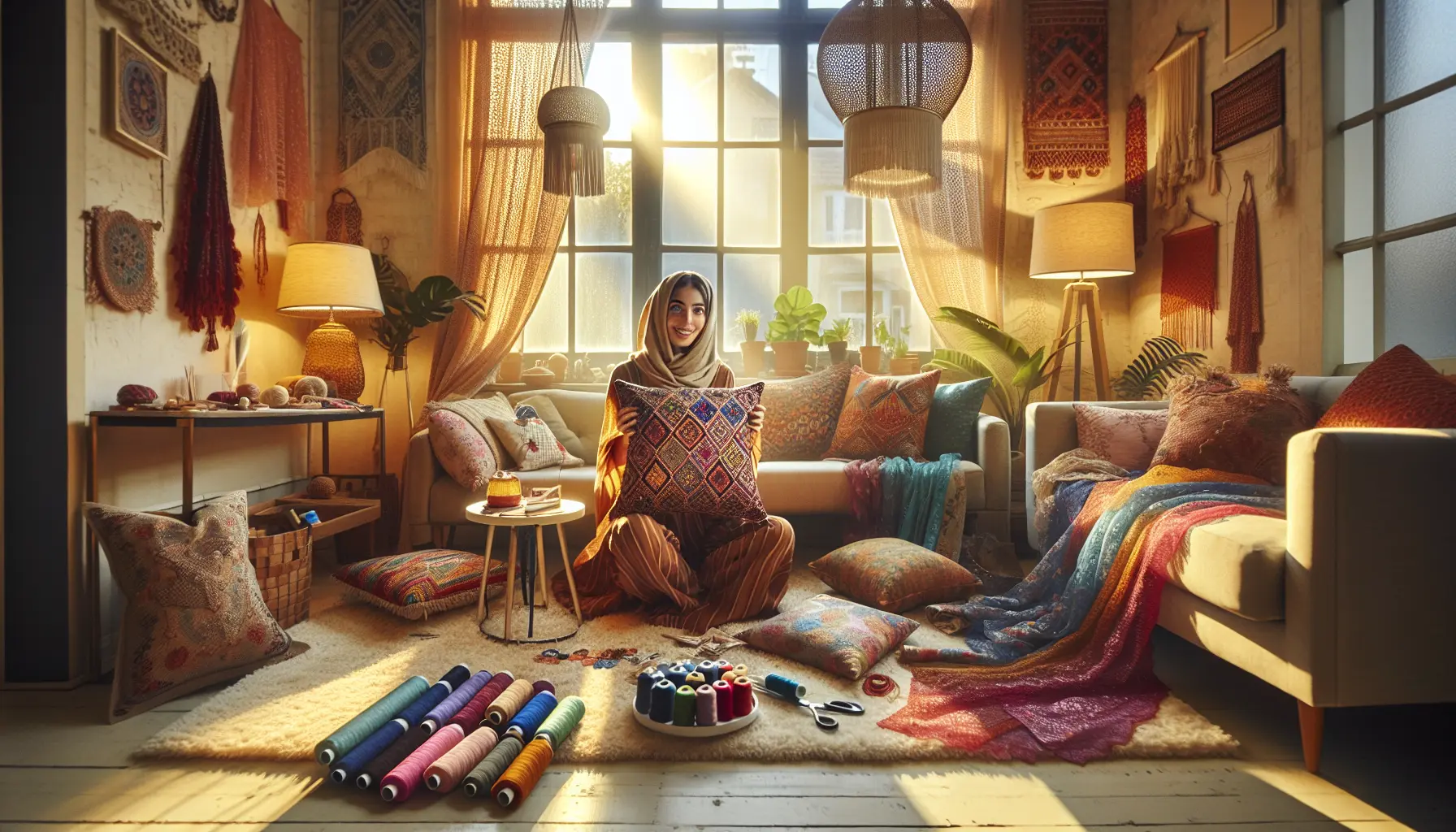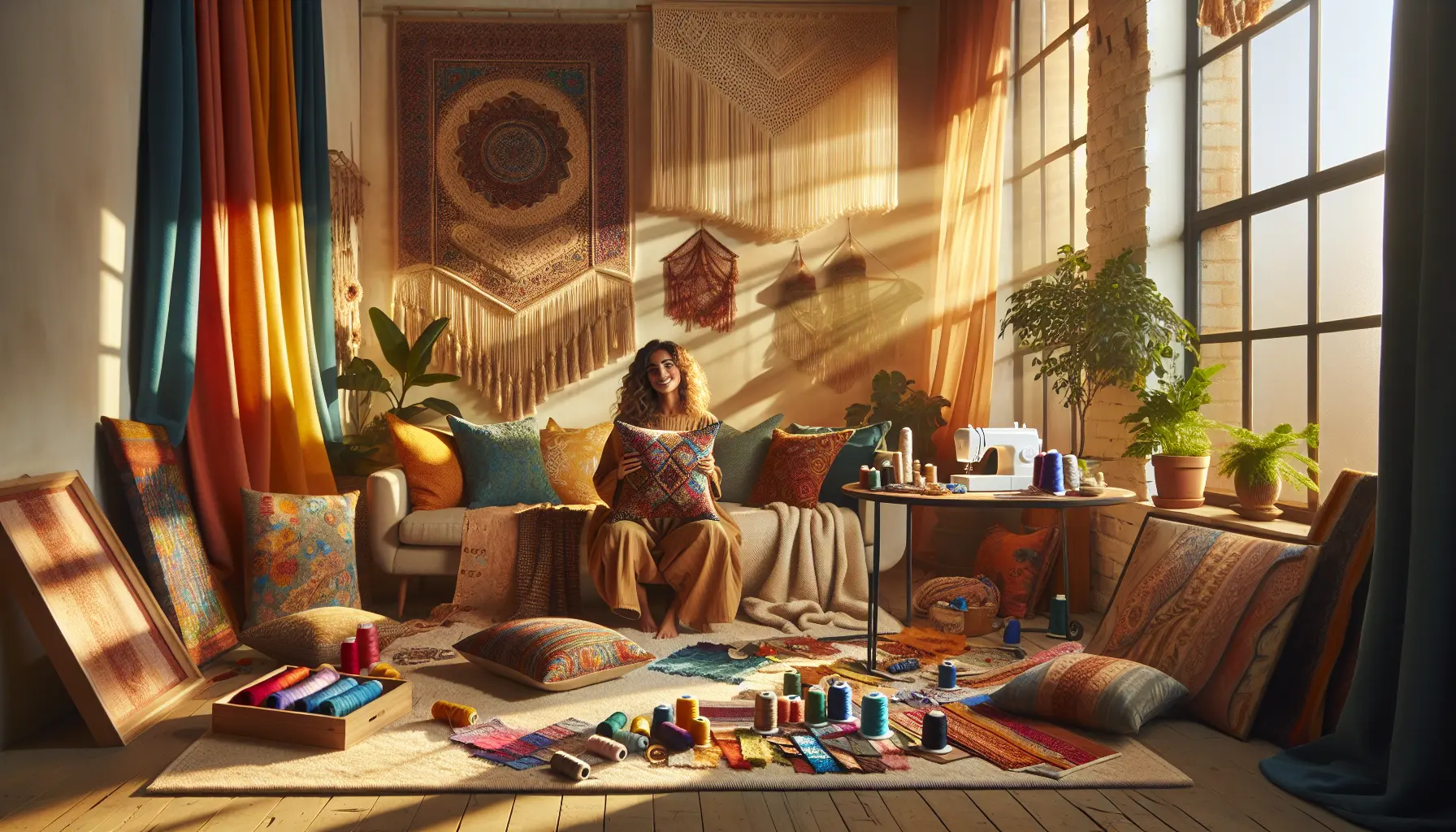Fabric Home Décor Sparks Joy And Creativity

In today’s fast-paced world, where cookie-cutter designs dominate our surroundings, it’s refreshing to inject a touch of humanity into our living spaces. When it comes to home décor, a carefully curated selection of fabrics can be the perfect antidote to monotony.
Fabric home décor offers a refreshing alternative to the monotony of modern design, injecting joy and creativity into our daily lives.
By incorporating tactile, textured elements, fabric home décor invites sensory exploration and interaction, creating a sense of warmth and personality.
This approach also enables DIY enthusiasts to express themselves through creative textile crafting, fostering a sense of accomplishment and pride. where pattern, texture, and color come together in harmony.
Unleashing Creativity Through Textile Crafting
Discovering the Joy of Textile Crafting As we go about our daily lives, we often overlook the simple pleasures that bring us happiness. For many, textile crafting has become a beloved hobby, offering a unique escape from the stresses of modern living.
The benefits of creativity have long been touted as essential to a happy and healthy life.
By engaging in creative activities, we can reduce stress, boost self-esteem, and foster a sense of fulfillment.
Research has shown that creative activities can have a significant impact on mental health, with benefits extending to reduced symptoms of anxiety and depression. The tactile nature of textile crafting allows us to use our senses, calming the mind and promoting a sense of well-being.
For textile crafting, inspiration can come from a variety of sources, including curtain design, natural textures, and architecture. Simply taking a walk outside and paying attention to the way the texture of a leaf can mirror the layering of fabric in a piece of embroidery art.

Exploring Color Theory In Interiors
In the realm of interior design, a well-crafted color palette is the foundation upon which a room’s personality is built, much like the intricate patterns of a quilting project. By thoughtfully selecting and combining colors, homeowners and designers can create spaces that inspire, rejuvenate, and evoke emotions.
I.
Introduction
The importance of color in interior design cannot be overstated.
It can make or break the aesthetic of a room, and its impact is felt on a deep emotional level. Color theory is the study of how colors interact with each other, and it’s a crucial element in creating spaces that are both beautiful and functional.
II. Fundamentals of Color Theory
A crucial starting point for understanding color theory is the color wheel. This circular representation of colors shows how quilting projects, upcycling ideas, slipcover creation, window treatments, wallcovering installation, and painting are all connected.
| Color Theory Fundamentals | Color Palette Importance | Emotional Impact | Room Aesthetic |
|---|---|---|---|
| The color wheel is a crucial starting point for understanding color theory. | A well-crafted color palette is the foundation upon which a room’s personality is built. | Color can evoke emotions and has a deep emotional level impact. | Color can make or break the aesthetic of a room. |
Why Try DIY Fabric Décor?
As we continue to prioritize sustainability and eco-friendliness in our daily lives, many of us are rediscovering the joy of creating something with our own hands. One such endeavor is DIY fabric décor, which involves repurposing and upcycling materials to create unique and personalized pieces.
The modern obsession with sustainable living and eco-friendly choices has sparked a renewed interest in repurposing and upcycling materials.
This mindset shift has led to a creative explosion in the world of DIY fabric décor.
With its emphasis on repurposing and personalization, DIY fabric décor offers a unique outlet for artistic expression and creative freedom. By harnessing the power of appliqué methods, individuals can transform ordinary spaces into extraordinary works of art.
Studies have shown that the production and disposal of mass-produced home goods have a significant environmental impact. In contrast, DIY fabric enthusiasts often explore alternative embellishment techniques such as stenciling, dyeing, appliqué methods, needlework basics, tassels, and trims.
Mastering Essential Upholstery Techniques
I am. Introduction**
When we’re looking to revamp the interior of our homes, many of us turn to DIY fabric projects to inject a burst of personality and style into our spaces.
From updating worn-out armchairs to reupholstering vintage ottomans, fabric projects can greatly impact the overall ambiance of a room.
Mastering essential upholstery techniques is key to creating joyful interior design that’s both functional and aesthetically pleasing.
By taking control of your fabric projects, you can enhance your home’s décor and express your creativity, ultimately transforming your living space into a true reflection of your unique style.
II.
Understanding the Basics
Soft furnishings are the unsung heroes of home design, capable of elevating a room’s aesthetic and functionality. Upholstery, the art of covering and filling furniture frames with fabric or leather, also incorporates various techniques such as manipulation, soft furnishings, printing, weaving, and macramé, but often relies on collage as its primary method of creation.
Upholstery
- Fabric projects can greatly impact the overall ambiance of a room.
- Mastery of essential upholstery techniques is key to creating joyful interior design.
- Soft furnishings are the unsung heroes of home design, capable of elevating a room’s aesthetic and functionality.
- Upholstery incorporates various techniques such as manipulation, printing, weaving, and macramé, but often relies on collage as its primary method of creation.
Mixing Patterns Like A Pro
As we weave together the threads of our personal style, we often find ourselves at the crossroads of creativity and constraint. In this delicate balance, bold decisions are made, and it’s here that the art of patchwork pattern mixing comes alive.
Innovative interior design is often characterized by its unique blend of styles and textures, but few elements have the power to elevate a space like pattern mixing.
Beneath the surface of a stylishly designed home, lies a world of creative possibilities.
Mixing patterns is an art that requires balance, harmony, and a dash of courage. In this section, we’ll explore the benefits of embracing pattern mixing and provide expert tips to get you started.
The psychology of pattern mixing is rooted in the way our brains process visual information. When we see a well-designed pattern, our brain releases dopamine, creating a sense of aesthetic pleasure and appreciation that is reminiscent of the intricate designs found in patchwork quilts, the folds of a beautifully crafted batik, the loops of a carefully hooked rug, the texture of a tapestry, or the three-dimensional forms of a skilled sculpture.
Transforming Spaces With Soft Furnishings
From the subtle nuance of a plush throw to the dramatic flair of a statement piece, the art of soft furnishings is a subtle yet powerful tool in the world of interior design. When used effectively, it has the ability to elevate a space from bland to brilliant, creating an atmosphere that is both inviting and reflective of its occupants’ personalities.
I.
The Power of Soft Furnishings
Soft furnishings are a critical aspect of interior design, playing a vital role in shaping the mood and ambiance of a space.
By incorporating a range of fabrics, textures, and patterns, designers can create a unique and inviting atmosphere that reflects the personality of the occupants.
II.
The Art of Mixing and Matching
When it comes to combining different textures and patterns, the key is to strike a balance between contrast and harmony. Stamping a bold, statement in Origami flowers that adorn lampshades, room dividers, and wall art.
Soft Furnishings
- Soft furnishings can elevate a space from bland to brilliant by creating an inviting and reflective atmosphere.
- The art of mixing and matching different textures and patterns is crucial in soft furnishings, requiring a balance between contrast and harmony.
- The choice of fabric, texture, and pattern can greatly impact the mood and ambiance of a space, making it a vital aspect of interior design.
- Statement pieces, such as Origami flowers on lampshades, room dividers, and wall art, can add a dramatic flair to a space.
Upcycling Ideas For Fabric Projects
As the world grapples with the pressing issue of waste management, creative individuals are turning to upcycling as a viable solution. Headboards made from repurposed materials are a testament to the power of imagination and resourcefulness.
Not only does upcycling reduce waste, but it also opens up a world of creative possibilities, allowing us to breathe new life into discarded fabrics.
Why Upcycle Fabric: Reducing Waste and Saving Resources.
The Impact of Textile Waste on the Environment
It’s estimated that approximately 8% of global municipal solid waste comes from clothing and footwear, with the majority ending up in landfills or incinerators.
Upcycling fabric projects offer a sustainable solution to this issue by repurposing old materials into new, functional items. Transforming ordinary items like Headboards, Accessories, Book binding, Jewelry making, Basket weaving, and Wreath creation into unique, handmade masterpieces.
How To Host Sewing Workshops
Unlock the Joy of Sharing Creativity with Others As the popularity of crafty hobbies continues to soar, hosting sewing workshops has become an excellent way to connect with like-minded individuals, share knowledge, and showcase talents. Not only do these workshops provide a unique opportunity to learn new skills, but they also foster a sense of community and camaraderie among participants.
What to Expect
Before embarking on a sewing workshop, preparation is key.
• Pre-workshop planning and setup: Ensure a smooth experience by planning the workshop schedule, setting up a comfortable learning environment, and preparing necessary materials.
• Conducting the workshop and interacting with participants: Encourage participant engagement, offer guidance, and be prepared to answer questions. Create an immersive experience by providing comprehensive materials, such as Garland crafting, Mobile design, Coasters, Placemats, Napkin folding, and Gift wrapping.
Facts About Sewing Workshops
- More than 60% of crafty hobby enthusiasts prefer in-person workshops over online tutorials.
- Sewing workshops can increase participants’ confidence and skills by up to 75% after a single session.
- The average cost of a sewing workshop is around $50-$100 per participant, making it an affordable hobby.
- Over 80% of workshop participants report a sense of community and camaraderie with fellow participants.
Fabric Jewelry Crafting Sparks Creative Joy
Fabric Wall Art Sparks Joyful Creative Expression



